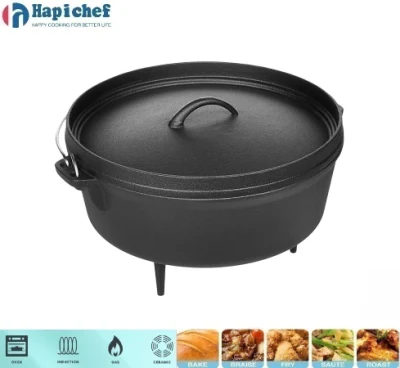Tips for Cooking with a Dutch Oven for Delicious Meals
The Versatile Wonder of Dutch Oven Cooking
When it comes to versatile kitchen tools, the Dutch oven stands out as a timeless favorite among both home cooks and professional chefs. Known for its heavy, cast-iron construction and excellent heat retention, the Dutch oven has a rich history and a multitude of uses, making it an essential piece of cookware in any kitchen. While it may seem like just a pot, its ability to adapt to various cooking methods enhances the culinary experience, adding depth to flavors and texture to dishes.
The History of the Dutch Oven
The Dutch oven’s origins can be traced back to the 18th century in the Netherlands, where skilled foundry workers developed a method for casting iron pots using sand molds. This technique led to the creation of durable and effective cooking vessels that were both affordable and efficient. The design was so popular that it made its way to England and then to America, where it became a quintessential kitchen staple. Over the centuries, the Dutch oven evolved, with many modern versions coated in enamel to prevent rust and make cleaning easier.
Versatility in Cooking Methods
One of the greatest strengths of the Dutch oven is its adaptability. It can be used on the stovetop or in the oven, and it excels in various cooking techniques, including sautéing, simmering, braising, baking, and even frying. This versatility means that one pot can handle everything from simmering a hearty chili to baking a delicious crusty bread.
For stovetop cooking, a Dutch oven is perfect for sautéing vegetables before adding broth and other ingredients, allowing for a depth of flavor that is hard to achieve in other cookware. Whether you're making a stew, soup, or sauce, the Dutch oven can evenly distribute heat, ensuring everything cooks uniformly.
Perfect for Slow Cooking
dutch oven use

The heavy lid of a Dutch oven helps to trap moisture and heat, making it ideal for slow-cooked meals. Dishes like coq au vin, beef bourguignon, or any braise are perfect candidates for a Dutch oven. The slow, even heat allows tougher cuts of meat to become tender and flavorful, while the flavors meld together beautifully over time.
Furthermore, for those who enjoy outdoor cooking, Dutch ovens can be used over open fires or charcoal, making them a favorite for camping and tailgating. It’s not uncommon to see these ovens surrounded by coals, cooking everything from stews to desserts in nature's embrace.
Baking Wonders
Beyond stews and braises, the Dutch oven is an extraordinary tool for baking. Its incredible heat retention makes it exceptional for bread baking. Many home bakers have discovered that placing a dough inside a preheated Dutch oven creates a steamy environment that mimics a professional bread oven. This results in a crusty exterior and a soft, airy interior that is simply irresistible.
Care and Maintenance
Proper care of a Dutch oven can ensure longevity and consistent performance. For enameled Dutch ovens, cleaning is straightforward; simply use mild dish soap and avoid abrasive sponges to maintain the enamel's integrity. For traditional cast iron versions, seasoning is crucial. After each use, it’s important to dry the pot thoroughly and apply a light coat of oil to prevent rust. Over time, this seasoning creates a non-stick surface that enhances flavor and texture in meals.
Conclusion
In conclusion, the Dutch oven is a remarkable kitchen tool that combines history, versatility, and functionality. Its ability to accommodate various cooking methods and endure high temperatures makes it suitable for almost any recipe imaginable. Whether you're simmering a stew, baking bread, or even frying, a Dutch oven can deliver exceptional results every time. With proper care, a Dutch oven can become a cherished companion in your culinary adventures, standing the test of time and trends. As many chefs will tell you, once you embrace the wonders of a Dutch oven, you may find it to be the most valuable piece of cookware in your kitchen.
-
Why Every Home Cook Needs a Cast Iron Meat PressNewsNov.12,2024
-
Unlock Perfectly Seared Steaks with the Cast Iron Meat PressNewsNov.12,2024
-
Master the Art of Cooking Thick Cuts of Meat with a Cast Iron Meat PressNewsNov.12,2024
-
How to Care for Your Cast Iron Meat Press: Tips for Longevity and PerformanceNewsNov.12,2024
-
How a Cast Iron Meat Press Enhances the Flavor and Texture of Your BurgersNewsNov.12,2024
-
Roasting Pan for Perfect MealsNewsNov.04,2024
-
Perfect Skillet for SaleNewsNov.04,2024
